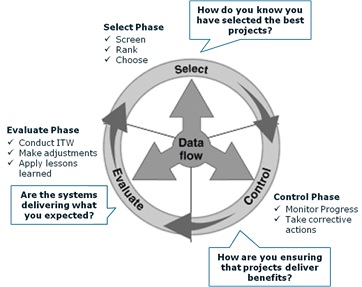
News
Press release
Four questions to…
Saad Bennani, managing partner, and David Frazier, IS&T Management Consultant at Karistem
« How project portfolio management improvements increase corporate profitability and contribute to cost effectiveness »
Why should firms invest in project portfolio management (PPM) improvements even if their project management practices are not optimal?

PPM is comprised of two linked disciplines: project management and project portfolio management. Many decision-makers understand the benefits of project management, because project management is a discipline that helps organizations to effectively realize business value by delivering projects and programs on time and within budget. However, some decision-makers may not recognize the benefits of project portfolio management, which goes beyond project-specific benefits to deliver business value across a portfolio of project investments. It is tempting for some to think that PPM focuses primarily on effective reporting across project portfolios. While effective reporting is certainly important, PPM actually helps organizations to realize business value, optimizing project portfolios by selecting and investing in the right projects. In other words, portfolio management helps you to select the right things to do while project management ensures you do things right. Successful organizations invest in both the tactical and strategic elements of project portfolio management.
If decision-makers in organizations understand the importance of project management to their bottom line, why don’t they also associate PPM improvements with their bottom line?
Business executives more readily grasp the tangible aspects of project management improvements designed to ensure projects are delivered on time and under budget. Once a business manager feels that any deviations from project schedule and budget targets are being addressed, they next focus on quality and customer satisfaction. This natural progression occurs because of the tangible nature of individual project results, and because such factors are more easily measurable. Understanding PPM and taking steps to improve PPM practices requires a leap in both understanding and sophistication due to the strategic nature of PPM. PPM helps organizations to align the right resources with the right activities at the right time. Resource management strategies feed the projects and programs that comprise portfolios. Therefore, it is critical for successful organizations to harmonize their decision-making apparatus in a proactive effort to maximize project portfolio benefits. Corporate strategy must be reflected in project selection and delivery processes to ensure alignment between a project portfolio and the bottom line. Executives and middle managers often miss the importance of this alignment process by focusing almost exclusively on firefighting and correcting project delivery issues. Additionally, PPM helps mature organizations correctly prioritize among the many demands on business leadership, which is very helpful in the current context, where IS&T budgets shrink in the face of increasing business pressures.
How can executives and middle managers effectively transition from a project-centric to a portfolio-centric organization?
First, it is important to continually improve project management processes to ensure any observed issues with project delivery get addressed. Next, it is important to raise awareness of PPM by assessing PPM maturity as well as project management maturity. PPM improvement occurs in tandem with project management improvement activities, starting with project selection. Project investment decisions must not only be based on the perceived value of delivering a specific project result, they must be made in the context of a project portfolio which considers project selection, project delivery, project results and continual realignment of the project portfolio as strategic direction shifts. Executives must invest in PPM in order to move away from reactive project-centric resource decision-making to enable more proactive portfolio-centric investment decisions. Smart Executives invest in the bottom line by making PPM a priority without diminishing the importance of project delivery.
And one last question. What are three key questions to ask in order to assess my firm’s PPM maturity?
Before answering, it is important to recognize that the PPM discipline is mature, comprising best practices, standards, methods, processes, tools designed help organizations to move forward. Examples include P3M3, ITIM and CPIC (*). In our experience, the most efficient and effective approach to adopting PPM is “don’t reinvent the wheel” by harnessing the benefits of proven models and methodologies. To assess PPM maturity in your organization, three questions to ask are:
- Is there a “PPM Board Instance” to ensure selected projects align with Corporate business objectives?
- What are the criteria used to select or prioritize among projects? Example criterion–a potential project’s level of alignment to strategic objectives.
- Assuming the value proposition of a project is based on an objective business case evaluation, who monitors project performance/achievements against initial baselines and rollout objectives?
(*) Portfolio Programme and Project Management Maturity Model (P3M3), Information Technology Investment Model (ITIM) and Capital Planning and Investment Control (CPIC)
–
After starting his career at BNP, Saad Bennani joined Capgemini in 1996, then Capgemini Consulting, in the “Business Transformation Practice.” He conducted numerous projects dealing with strategic planning, governance and skills assessment, all within the framework of profound reorganization of corporate functions such as Sourcing, Supply Chain, Information Systems, etc… In 2004, he co-founded Karistem, where he works primarily on assignments scoping transformation projects for the support functions or projects to improve performance.
David Frazier, a project management (PMP) and ITIL certified professional, has over 28 years of experience providing strategic management consulting support to Chief Information Officers in multi-national and government organizations across the U.S and the EU. He left Booz Allen Hamilton in 2001 to start his own consulting business, and he moved to France in 2013 after serving as the Deputy Policy Director for the Office of Logistics and Acquisition within the National Institutes of Health. Since 2014, David Frazier provides PPM and ITIL expertise as an affiliate of Karistem Corporate Expertise (KCE). He conducts maturity assessments of project management and PPM conformity to industry best practices as well as ITIL process maturity. He works directly with KCE clients to provide analysis, advice and training designed to improve operational efficiencies in project and portfolio management as well as ITIL processes.
–
Karistem Corporate Consulting briefly.
Karistem Corporate Consulting (KCC) is a consulting firm specializing in strategy, transformation and operational excellence. Since 2004, KCC develops and implements major transformation projects supported by the Exectutive Managament to improve the competitiveness of the heart of business and / or support functions to align the business strategy. KCC’s approach is results-oriented and puts people at the heart of each transformation. KCC is committed (1) the involvement and ownership of the change by the largest number of people and (2) on fast, major and lasting results.
www.karistem-consulting.com
–
Press Contact
Sebastien de Boisfleury
Head of Communications & Marketing
Mail : sebastien.de-boisfleury@karistem.com




